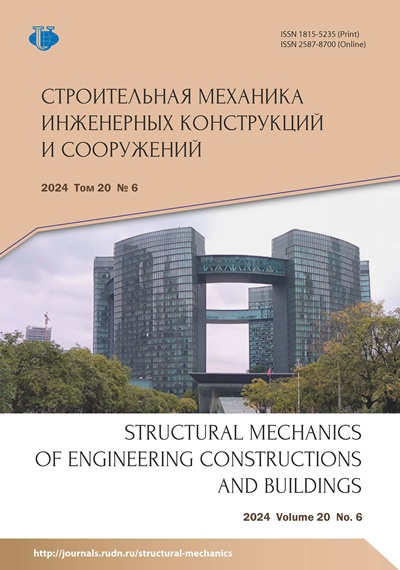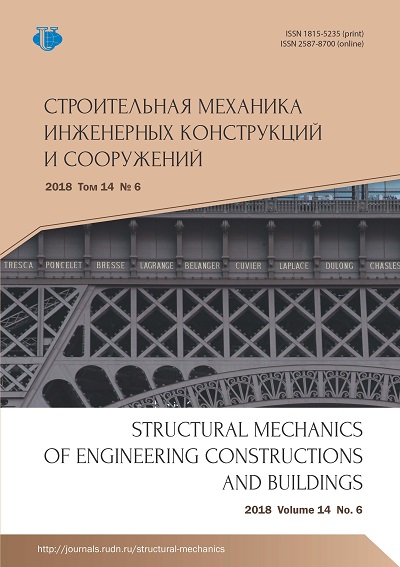Comparative analysis of efficiency of use of finite elements of different dimensionality in the analysis of the stress-strain state of thin shells
- Authors: Klochkov Y.V1, Nikolaev A.P1, Sobolevskaya T.A1, Klochkov M.Y.2
-
Affiliations:
- Volgograd State Agricultural University
- Lomonosov Moscow state University
- Issue: Vol 14, No 6 (2018)
- Pages: 459-466
- Section: Numerical methods of structures’ analysis
- URL: https://journals.rudn.ru/structural-mechanics/article/view/20423
- DOI: https://doi.org/10.22363/1815-5235-2018-14-6-459-466
Cite item
Full Text
Abstract
Relevance. To determine the stress-strain state (SSS) of thin-walled shells due to the complexity of obtaining numerical results, the theory of thin shells was developed with the introduction of the direct normal hypothesis to reduce the three-dimensional SSS to the two-dimensional one. With the modern development of digital technology and numerical methods of calculation, in particular the finite element method (FEM), it became possible to obtain numerical results without the use of the direct normal hypothesis, namely on the basis of the theory of elasticity in three-dimensional formulation even for thin shells. Aims. The aim of this work is to compare the efficiency of algorithms for the use of finite element stiffness matrices obtained on the basis of the theory of thin shells with the hypothesis of a straight normal and on the basis of the relations of the three-dimensional theory of elasticity. Methods. The results of comparative analysis of finite element calculations of thin shells using a two-dimensional sampling element in the form of a quadrangular fragment of the middle surface and a three-dimensional element in the form of an eight-node six-face are presented. The components of the displacement vector and their first derivatives were chosen as the nodal variable parameters. The functions of the form for both types of discretization elements were represented by products of Hermite polynomials of the third degree. Results. On the example of calculation of the cylindrical shell clamped at the ends it is shown that the two-dimensional statement in calculations of thin shells is adequate and allows to receive acceptable results at optimum costs of machine time.
About the authors
Yuriy V Klochkov
Volgograd State Agricultural University
Author for correspondence.
Email: klotchkov@bk.ru
Dr Sci. (Eng.), Professor, Head of the Department of Higher Mathematics
26 University Ave., Volgograd, 400002, Russian FederationAnatoliy P Nikolaev
Volgograd State Agricultural University
Email: anpetr40@yandex.ru
Dr Sci. (Eng.), Professor, Professor of the Department of Applied Geodesy, Environmental Engineering and Water Use
26 University Ave., Volgograd, 400002, Russian FederationTatyana A Sobolevskaya
Volgograd State Agricultural University
Email: moonway13@rambler.ru
Cand. Sci. (Eng.), Associate Professor of Higher Mathematics Department
26 University Ave., Volgograd, 400002, Russian FederationMikhail Yu Klochkov
Lomonosov Moscow state University
Email: m.klo4koff@yandex.ru
a third-year student of the Faculty of Physics
1 Leninskiye Gory, Moscow, 119899, Russian FederationReferences
- Krivoshapko S.N., Galishnikova V.V. (2015). Arhitekturno-stroitel’nye konstrukcii: uchebnik dlya akademicheskogo bakalavriata [Architectural and building structures: a textbook for academic undergraduate]. Moscow, Urait Publ., 476. (In Russ.)
- Krivoshapko S.N., Gil-Oulbe M. (2013). Geometry and strength of a shell of velaroidal type on annulus plan with two families of sinusoids. International Journal of Soft Computing and Engineering (IJSCE), 3(3), 71–73.
- Krivoshapko S.N., Gbaguidi-Aisse G.L. (2016). Geometry, static, vibration and bucking analysis and applications to thin elliptic paraboloid shells. The Open Construction and Building Technology Journal, 10, 3–28.
- Storozhuk E.A., Yatsura A.V. (2016). Exact solutions of boundary-value problems for noncircular cylindrical shells. International Applied Mechanics, 54(4), 386–397.
- Storozhuk E.A., Yatsura A.V. (2017). Analyticalnumerical solution of static problems for noncircular cylindrical shells of variable thickness. International Applied Mechanics, 53(3), 313–325.
- Bespalova E.I., Urusova G.P. (2015). Stress state of branched shells of revolution subject to transverse shear and reduction. International Applied Mechanics, 51(4), 410–419.
- Pyatikrestovskiy K.P., Travush V.I. (2015). O programmirovanii nelineynogo metoda rascheta derevyannyh konstruktsiy [On programming non-linear method for calculating wooden structures]. Academia. Arhitektura i stroitel’stvo, (2), 115–119. (In Russ.)
- Solodovnikov A.S., Sheshenin S.V. (2017). Numerical study of strength properties for a composite material with short reinforcing fibers. Moscow University Mechanics Bulletin, 72(4), 94–100.
- Kim A.Yu. (2005). Iteratsionniy metod prirascheniy parametrov dlya rascheta nelineynih membranno-pnevmaticheskih system s uchetom uprugoy raboty vozduha [Iterative method of increments of parameters for the calculation of nonlinear membrane-pneumatic systems, taking into account the elastic operation of the air]. Vestnik Saratovskogo gosagrouniverciteta im. N.I. Vavilova, (1), 39–42. (In Russ.)
- Paimushin V.N. (2016). On the forms of loss of stability of a cylindrical shell under an external side pressure. Journal of Applied Mathematics and Mechanics, 80(1), 65–72.
- Ignat’ev A.V., Ignat’ev V.A., Gazmatova E.A. (2018). Raschet tonkih plastin po metodu konechnih elementov v forme klassicheskogo smeshannogo metoda s isklyucheniem peremesheniy konechnih elementov kak zhestkogo tselogo [Calculation of thin plates according to the finite element method in the form of the classical mixed method with the exception of the displacements of finite elements as a rigid whole]. Izvestiya visshih uchebnih zavedeniy. Stroitel’stvo, 3(711), 5–13. (In Russ.)
- Golovanov A.I., Tyuleneva O.N., Shigabutdinov A.F. (2006). Metod konechnih elementov v statike i dinamike tonkostennyh konstruktsiy [The finite element method in statics and dynamics of thin-walled structures]. Moscow, Fizmatlit Publ., 392. (In Russ.)
- Bazhenov V.A., Krivenko O.P., Solovey N.A. (2013). Nelineynoe deformirovanie i ustoychivost’ uprugih obolochek neodnorodnoy strukturi: modeli, metody, algoritmy, maloizuhennye i novye zadachi [Nonlinear deformation and stability of elastic shells of an inhomogeneous structure: models, methods, algorithms, little-studied and new problems]. Moscow, Librikom publ., 336. (In Russ.)
- Zheleznov L.P., Kabanov V.V., Boiko D.V. (2014). Nonlinear deformation and stability of discretely reinforced elliptical cylindrical shells under transverse bending and internal pressure. Russian Aeronautics, 57(2), 118–126.
- Agapov V.P., Aydemirov K.R. (2016). Raschet ferm metodom konechnyh elementov s uchetom geoetricheskoy nelineynosti [Calculation of farms by the method of finite elements with regard to geometric nonlinearity]. Promyshlennoe i grazhdanskoe stroitel’stvo [Industrial and civil engineering], (11), 4–7. (In Russ.)
- Kayumov P.A., Shakirzyanov F.R., Gavryushin S.S. (2014). Modelirovanie protsessa deformirovaniya i otsenka nesuschey sposobnosti sistemy grunt – tonkostennaya konstruktsiya [Simulation of the deformation process and assessment of the bearing capacity of the soil system – thinwalled structure]. Izvestiya visshih uchebnih zavedeniy. Mashinostroenie, (6), 20–24. (In Russ.)
- Bate K.-Yu. (2010). Methody konechnyh elementov. Moscow, Fizmatlit Publ., 1022. (In Russ.)
- Kositsyn S.B., Akulich V.Yu. (2018). Ob odnom chislennom sposobe opredeleniya osadki poverhnosti gruntovogo massiva, vizvannoy sooruzheniem obolochki obdelki tonnelya [On one numerical method for determining the precipitation of the surface of the soil massif, caused by the construction of the shell of the tunnel lining]. International Journal for Computational Civil and Structural Engineering, 14(1), 78–91. (In Russ.)
- Klochkov Y.V., Nikolaev A.P., Kiseleva T.A. (2015). A comparative evaluation of the scalar and vector approximations of sought quantities in the finite-element method of arbitrary shells. Journal of Machinery Manufacture and Reliability, 44(2), 166–172.
- Nikolaev A.P., Bandurin N.G., Kiselev A.P., Sizyh A.A. (2005). Opredelenie napryazheniy v stenkah izotermicheskogo rezervuara dlya tramsportirovki szhizhennogo gaza v mestah deystviya opor [Determination of stresses in the walls of an isothermal tank for transporting liquefied gas in places of action of supports]. Izvestiya visshih uchebnih zavedeniy. Severo-Kavkazskiy region. Seriya: Thehnicheskie nauki, (2), 54a–57. (In Russ.)
- Zienkiewicz O.C., Taylor R.L. (2005). The finite element method for solid and structural mechanics. Elsevier, 631.
















